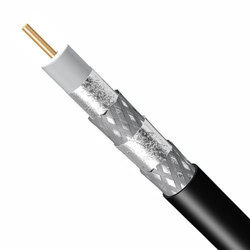单芯或多芯电缆, 如何选择


有两种类型的电缆, 单芯电缆和多芯电缆.
因为布线是最受欢迎的 (在大多数情况下,唯一的) 为网站供电的方法.
所以, 他们无处不在. 你可以在家里找到它们, 工厂, 公共建筑, 道路和购物中心.
单芯地下电缆可能不可见,因为它被埋在沟渠中, 而多芯电缆应用程序可能对所有人可见, 在墙壁或天花板上运行.
这就提出了一个问题: 什么是单芯电缆或多芯电缆?
为什么选择使用多芯电缆而不是单芯电缆?
在下一篇文章中, 我们将讨论这些问题并为您提供答案.
阅读提供的信息后, 您将能够与当局沟通, 在讨论下一个电缆项目的电缆采购时,单核或多核有线供应商.
什么是单核电缆?
这个问题的答案在于问题本身. The term “single core” is used to describe 带有单个导体的电缆.
这些与其他类型的电缆不同, 被构造为多核电缆类型.
单核电缆中的导体可以由铜或铝绝缘材料制成.
与某些人的想法相反, 单核电缆不一定比多核电缆更灵活或更灵活, 或更厚或更薄.
这些特征 (厚度, 薄, 灵活性, 或僵硬) 通常取决于用于特定应用的单核电缆的大小.
大小和厚度取决于电缆的大小. 大直径电缆不如小直径电缆灵活.
什么是单核电缆用于?
单核电缆可能是我们家中使用最广泛的电线之一, 商店, 企业和商业设施.
最多 单链电缆的常用 是将电源从一个位置传递到另一个位置.
然而, 取决于所需的单核电缆尺寸, 它的应用程序也可以扩展到其他字段, 例如电器和设备中的接线.
您也可能会看到单一核心, 用于电气应用的非护套电缆, 包括计算机的电源, 电源控制面板, 和电子设备.
对于有风险的应用 电磁干扰 (电磁干扰), 您还可以获取带有特殊制造的盾牌的单核线.
类似的配置屏蔽也可以用于灵活的多核电缆. 这款屏蔽电缆也称为编织电缆.
损坏其功能, 例如来自通信设备的信号或高功率电气或电子设备的电磁脉冲.
例如, 如果电缆在微波炉附近或家用烹饪设备附近通过, 电工可以使用单核编织电缆保护电缆.
相似地, 如果接线应用程序通过发电机附近, 总是存在发电机的EMI可能影响电缆完整性的风险.
在这种情况下, 可以使用多核或单核编织电缆.
编织或屏蔽有另一种用途.
有时, 工程师可能会在需要稍强的电缆的应用中使用编织或屏蔽的单核灵活电缆.
编织金属辫子具有双重用途.
第一的, 它有助于减少EMI, 这可能会危害布线应用程序.
然而, 与未屏蔽类型相比,单核编织电缆的使用可以增强整体电缆强度.
它可以保护电缆免受机械压力,并延长其使用寿命.
最后, 带有辫子的单核线也用于工程师需要电缆以显示额外灵活性的应用.
因为辫子是作为交错的晶格管制造的, 单核编织电缆或类似的多核电缆, 它增强了下面的绝缘导体,并为整个电缆增添了灵活性和多功能性.
例如, 此方法用于接线应用中,在安装过程中,单线电缆可能会遇到张力和失真.
当需要灵活的多核电缆时,同样的概念也适用.
单核电缆的优点和缺点?
一般来说, 应用程序的性质和类型确定路由选择的类型.
例如, 取决于您的项目目标, 您可以决定是否使用6mm单核电缆.
但是对于另一个应用程序, 这可能不是最合适的电缆.
每种电缆都有其优势, 使工程师和电工可以为其项目选择特定电缆.
如果0.75mm的单核电缆是室内应用的不错选择, 它可能不是户外应用程序的最佳选择.
然而, 在另一种类型的电缆上使用一种类型的电缆具有优势和缺点.
单芯电缆的优势:
- 易于安装阶段
- 多个阶段之间短路的可能性很小
- 方便长途运输 (例如, 一卷10mm的单芯电缆更容易 (并占用更少的空间) 比等效的多核电缆类型)
- 易于安排和安装
- 更长的电缆可以与多核电缆相同的横截面容量使用
单核电缆的缺点:
这些电缆不能装甲,因此不适合有机械压力风险的应用.
由于没有盔甲, 单核电缆更容易受到外部力量.
装甲电缆是需要在严重条件下安装电缆的应用的首选.
例如, 由于2.5毫米单芯电缆不能用磁性钢条或磁条装甲.
在坚固耐用的环境中安装相同尺寸的多核电缆更具挑战性.
单核电缆仅受单个外套保护, 这使他们更容易受到伤害.
对住房的轻微损坏可能会导致短路.
在高利用应用中, 单核电缆必须在多个点接地, 这可能导致流通的风险.
在哪里购买单核电缆?
因此, 电缆更有可能过热并最终耗尽, 我在哪里可以买到高质量的单核电缆?
现在您已经熟悉单核电缆和多核电缆之间的区别
还, 您已经知道选择一根电缆的优势和缺点.
您可以更好地对有线采购做出明智的决定.
了解有关制造商是谁的更多信息.
在ZMS电缆, 我们为各种应用提供各种单核电缆.
我们还是领先的制造商和多核电缆供应商.
我们的产品经过详细的质量控制过程,并按照最高国际标准进行测试.
Recent Posts
How to quickly understand what three-phase cable is? Favorite here!
In the world of industrial and commercial power distribution, three-phase cables play a critical role…
电缆行业在循环经济中的作用和挑战
简介 随着可持续发展成为全球优先事项, industries across the spectrum are reevaluating their operations…
可再生能源对电缆需求的影响
Introduction The global shift toward renewable energy has become a cornerstone of efforts to combat…
